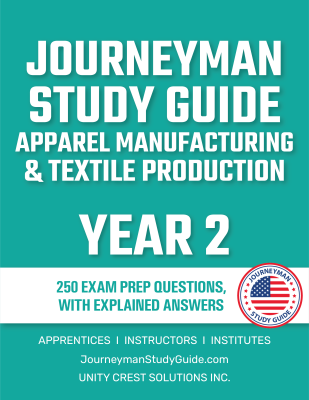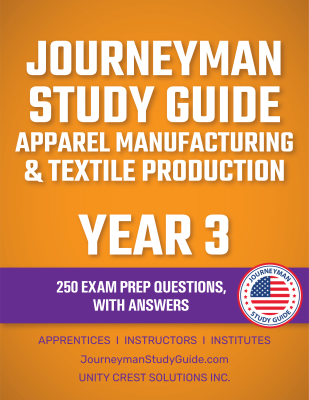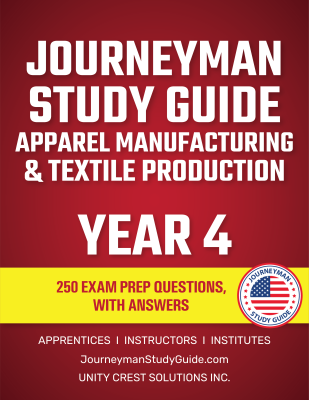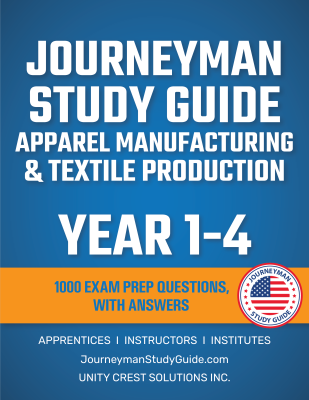Questions, Answers, & Explanations
Get clear explanations behind every answer, perfect for deeper learning and more thorough exam preparation.
Site Updates in Progress: Things might look different as we work on enhancing your experience.
What is Apparel Manufacturing & Textile Production?
Apparel manufacturing and textile production involve the design, creation, and assembly of clothing, fabrics, and related materials. This trade is a cornerstone of the American economy, supporting industries such as fashion, workwear, military uniforms, and industrial textiles. Professionals in this field work with raw fibers, woven fabrics, and advanced textile technologies to produce everything from high-end fashion to durable industrial gear. With a growing focus on sustainability and automation, apparel manufacturing is an evolving and essential trade.
Key Responsibilities
Textile and apparel production professionals handle a variety of tasks that require technical skill, attention to detail, and an understanding of industry standards:
Skills and Traits for Success
Success in apparel manufacturing and textile production requires both hands-on ability and industry knowledge:
Industries Where Apparel Manufacturing & Textile Production Thrive
Why Choose This Career?
A career in apparel manufacturing and textile production offers a variety of opportunities and benefits:
Ready to Start Your Career in Apparel Manufacturing & Textile Production?
Prepare for success with our study guides, Q&A products, and interactive online tests designed specifically for aspiring professionals in textile and apparel production. Build your knowledge, master key concepts, and get ready for certification with our expertly crafted resources.
What to Expect on the Apparel Manufacturing & Textile Production Certification Exam
The Apparel Manufacturing & Textile Production Certification Exam ensures that professionals meet U.S. industry standards for garment and textile production. Many American employers, trade associations, and unions require certification as proof of expertise in fabric selection, garment construction, and safety protocols. Earning certification demonstrates proficiency in industry techniques, machinery operation, and regulatory compliance, making you a valuable asset in the apparel and textile industry.
Exam Format
The certification exam assesses both theoretical knowledge and practical skills. Here’s what to expect:
Key Topics Covered
The exam is structured to assess critical skills and industry knowledge:
1. Safety and Workplace Practices
2. Textile Materials and Fabric Construction
3. Apparel Manufacturing Techniques
4. Industrial Machinery and Technology
5. Mathematical Applications
Passing Requirements
Most certification programs require a minimum score of 70% or higher to pass. Some exams may include a hands-on practical assessment, where candidates must demonstrate key manufacturing techniques with precision and safety compliance.
Tips for Preparing Effectively
Ready to Pass Your Exam?
Prepare for certification with our expertly crafted study guides, detailed Q&A explanations, and interactive online tests tailored specifically for apparel manufacturing and textile production.
What Types of Questions Are on the Apparel Manufacturing & Textile Production Certification Exam?
The Apparel Manufacturing & Textile Production Certification Exam assesses your knowledge of textile materials, production processes, safety standards, and industry best practices. The exam includes a variety of question formats designed to evaluate your ability to manage textile machinery, oversee quality control, and adhere to workplace safety regulations. Understanding these question types will help you prepare effectively and demonstrate your skills with confidence.
Common Question Formats
Here’s an overview of the types of questions you can expect:
1. Multiple-Choice Questions
These questions test your foundational knowledge of textile production, material selection, and machine operations. Each question includes four answer options, with one correct choice.
2. Scenario-Based Questions
Real-world production scenarios challenge you to apply your knowledge to workplace situations. These questions may ask how to troubleshoot a malfunctioning sewing machine, ensure fabric consistency in large-scale manufacturing, or improve production efficiency in a factory setting.
3. Calculation Questions (Math-Based)
Math-related questions assess your ability to estimate fabric yardage, calculate production efficiency, and determine material costs. These questions require basic arithmetic, unit conversions, and an understanding of textile measurements.
4. Equipment and Material Identification
These questions require recognizing different types of fabrics, industrial sewing machines, cutting tools, and textile finishing techniques. You may be asked to identify materials such as cotton twill, polyester blends, or water-resistant coatings used in workwear and outerwear production.
Sample Questions
Below are examples of the types of questions you might encounter on the exam:
1. Safety and Workplace Practices
Question: "What is the primary safety concern when operating an industrial fabric-cutting machine?"
Answer: C) Keeping hands and fingers clear of the cutting path
2. Textile Materials and Fabric Construction
Question: "Which fabric is known for its durability, breathability, and moisture-wicking properties, making it ideal for sportswear?"
Answer: A) Polyester
3. Math for Textile Production
Question: "A fabric roll contains 500 yards of material. If each garment requires 2.5 yards, how many garments can be produced from the roll?"
Answer: C) 200
4. Equipment Identification
Question: "Which machine is commonly used in large-scale apparel manufacturing to stitch fabric panels together with high precision?"
Answer: A) Overlock sewing machine
Tips for Answering Exam Questions
Practice Questions for Better Preparation
Engaging with practice exams is one of the most effective ways to improve performance. Benefits include:
Our Q&A with Explanations helps you understand why answers are correct, while our Online Tests simulate real testing conditions with live scoring and feedback.
Want More Practice?
Access hundreds of practice questions, detailed explanations, and interactive tests tailored for aspiring apparel manufacturing professionals. Improve your confidence and ensure success on exam day.
What Is It Like to Work in Apparel Manufacturing & Textile Production?
The daily life of a professional in apparel manufacturing and textile production is fast-paced, detail-oriented, and hands-on. Workers contribute to the production of clothing, industrial fabrics, and specialty textiles used in everything from athletic wear to military uniforms. Whether in a small garment shop or a large-scale factory, each day presents unique challenges and rewards.
Morning: Preparing for Production
The workday typically begins early, around 6:30 or 7:00 AM, with preparation and planning:
Midday: Production and Problem-Solving
Most of the day is spent actively working on textile production tasks:
Afternoon: Quality Control and Finalization
Challenges and Rewards
Ready to Start Your Career in Apparel Manufacturing?
Prepare with our study guides, Q&A products, and interactive online tests designed to help you master certification exams and excel in the field.
What Are the Long-Term Benefits of a Career in Apparel Manufacturing & Textile Production?
A career in apparel manufacturing and textile production offers long-term stability, competitive wages, and opportunities for specialization. Whether working in design, production management, or textile technology, professionals in this field play a crucial role in the American economy. With advancements in automation and sustainable textiles, this industry continues to evolve, creating new opportunities for skilled workers.
Earning Potential in Apparel Manufacturing
Salaries in the apparel and textile production industry vary based on experience, specialization, and location:
1. Entry-Level (Machine Operator, Fabric Cutter, or Sewing Technician)
2. Mid-Level (Production Supervisor, Pattern Maker, or Quality Control Specialist)
3. Advanced-Level (Textile Engineer, Manufacturing Manager, or Technical Designer)
Career Growth Opportunities
1. Specialization
2. Supervisory and Management Roles
3. Union Membership Benefits
4. Business Ownership
The Importance of Certification
Why Choose a Career in Apparel Manufacturing?
Ready to Advance Your Career in Apparel Manufacturing?
Prepare for certification and long-term success with our study guides, Q&A materials, and interactive online tests designed for apparel professionals.
How Much Can You Earn in Apparel Manufacturing & Textile Production?
Salaries in the apparel manufacturing industry depend on factors such as experience, certification, job location, and specialization. Whether you are starting as a sewing machine operator or advancing into textile engineering, apparel production offers competitive earnings and career stability.
General Wage Ranges
1. Entry-Level (Machine Operator, Cutter, or Assembler)
2. Certified Journeyperson (Pattern Maker, Textile Technician, or Production Supervisor)
3. Advanced-Level (Manufacturing Manager, Textile Engineer, or Product Development Specialist)
Regional Salary Differences
1. Northeast (New York, Massachusetts, Pennsylvania)
2. South (North Carolina, Georgia, Tennessee)
3. West Coast (California, Oregon, Washington)
Factors That Impact Wages
Want to Boost Your Earning Potential?
Advance your career with our study guides, Q&A products, and interactive online tests to enhance your skills and increase your earning power.
What Tools and Resources Do Apparel Manufacturing Professionals Need?
Apparel manufacturing professionals rely on essential tools and learning resources to enhance precision, efficiency, and safety. Whether you’re an entry-level sewing technician or an experienced production manager, having the right equipment and educational materials is crucial.
Essential Tools for Apparel Manufacturing
1. Sewing and Cutting Tools
2. Pattern Making and Design Tools
3. Safety Gear and Compliance Equipment
Recommended Learning Resources
1. Industry Certifications and Training
2. Trade Associations and Unions
Looking for the Best Study Materials?
Prepare for certification and career success with our study guides, Q&A products, and interactive online tests designed for apparel manufacturing professionals.
Where Can You Learn Apparel and Textile Production in the U.S.?
Apparel Manufacturing and Textile Production careers start with hands-on education. Whether you’re interested in industrial sewing, textile science, or fabric innovation, American training programs offer specialized knowledge and practical experience to prepare you for a skilled position in the industry.
From large-scale factories in North Carolina to sustainable fashion labs in California, U.S. schools and unions are expanding training to meet the demand for skilled workers in cut-and-sew operations, technical fabric production, and automated textile manufacturing.
Types of Apparel & Textile Programs
What You’ll Learn
Choosing the Right Program
Ready to Learn the Trade?
Pair your program with our Q&A resources, Q/A Explanations, and Online Tests to reinforce your skills and pass industry certifications with confidence.
Why Join a Union or Connect with Employers?
Unions and reputable employers provide apparel manufacturing professionals with job security, competitive wages, and career advancement opportunities. Union membership offers specialized training, benefits, and worker representation, while working with established employers ensures consistent work and professional growth. Leveraging these connections is essential for success in the American textile industry.
Benefits of Joining a Union
1. Higher Wages and Benefits
2. Job Security
3. Advanced Training
4. Worker Representation
Top Unions for Apparel Manufacturing Professionals
1. Workers United
2. United Food and Commercial Workers International Union (UFCW)
Connecting with Employers
1. Types of Employers
2. What Employers Look For
3. How to Stand Out
Tips for Finding Work Through Unions and Employers
Ready to Connect with the Best Opportunities?
Explore our study guides, union resources, and employer connections to advance your career in apparel manufacturing.
How to Stay Ahead in the Apparel Manufacturing Industry
The apparel and textile industry is evolving with advancements in automation, sustainability, and digital fabrication. Staying competitive requires continuous learning, networking, and adapting to emerging trends.
Emerging Trends in Apparel Manufacturing
1. Advanced Materials
2. Sustainability in Production
3. Automation and Smart Factories
Best Practices for Professional Growth
1. Continuing Education
2. Networking
3. Building a Professional Portfolio
4. Adapting to Market Demands
Challenges and Opportunities
1. Labor Shortages
2. Adapting to Technological Changes
3. Stricter Regulations
Sustainability in Practice
1. Reducing Environmental Impact
2. Waste Reduction Strategies
3. Green Manufacturing Techniques
Why Staying Ahead Matters
The apparel and textile industry is constantly evolving. Staying informed, upgrading skills, and embracing new technologies keep professionals competitive and valuable in the workforce.
Stay Informed, Stay Competitive
Prepare for success with our specialized study guides, certification materials, and insider resources for apparel manufacturing professionals.
Get clear explanations behind every answer, perfect for deeper learning and more thorough exam preparation.
Quick and easy practice to test your knowledge anytime, anywhere—ideal for simple, on-the-go preparation.










